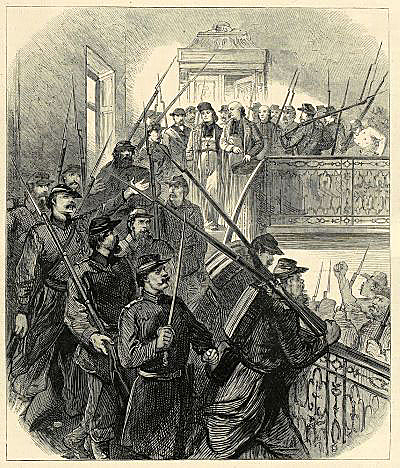UNTIL THE 1980's, THE CONTRAST BETWEEN THE ARMY'S BARBARISM AND LA COMMUNE'S PACIFISM SEEMED SELF-EVIDENT
Since then, La Commune has been "demystified" by emphasizing its rare executions and downplaying those of the army.
# # #
Communard violence:
- La Commune did arrest 70 guards and clergymen at the start of the conflict in reprisal for Versailles killings, as bargaining chips and to slow down shootings,* that is, in self-defense. A decree demanding shootings as reprisals was not applied. For the general absence of coercion, please click and scroll down.
 |
The Arrest of Monseigneur Darboy, newspaper illustration / zoom |
*During her deportation Louise Michel met 31 Communards whom that halt in killing had saved.
- Except for the shootings of the Archbishop and five other hostages — inexcusable but due to Ferré alone — it ordered only nine executions, for reasons that are considered legitimate in wartime:
1. A man who sold plans of a fort to Versailles, the only execution before Bloody Week.
-- Lissagary, Annex XVI
2. A man who tried to corrupt a Commune member.
-- Vuillaume, Le Fusillé [the shot man] du pont Neuf "Mes Cahiers Rouges" , p.355
3.4.5. Three spies.
6.7.8.9. The commander accused of firing on the crowd at City Hall on January 22 and three policemen, also due to Ferré. Vuillaume thinks that Breton fanatics were responsible for that shooting, but since the commander said only that he "did his duty," Ferré's choice is understandable.
-- Vuillaume, Gustave Chaudey, "Mes Cahiers Rouges" pp. 435-484
- The killings by mobs were due to panic. Commune members tried to stop them.
In short, the Communards executed 15 people, 14 during the anguish of Bloody Week. Of those, nine were legitimate in war.
So illegitimate shootings: six.
Current revisionism
emphasizes those few executions
and downplays army carnage:
Please read on.
* * *

No comments:
Post a Comment